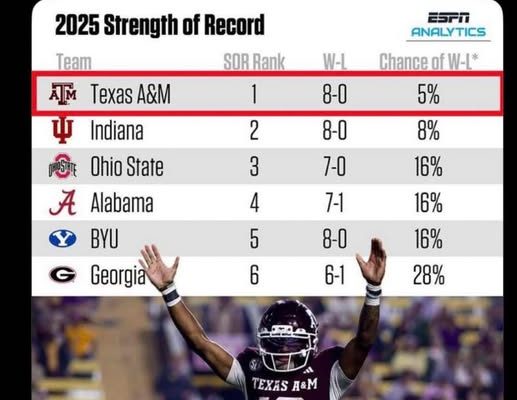Recent data on strength of record has ignited a fresh debate across the college football landscape, revealing a surprising truth about the schedules faced by some of the nation’s most talked-about programs. While Alabama has long been considered the benchmark for strength and consistency in college football, this season’s numbers paint a different picture. Both Ohio State and Indiana, two programs with very different reputations and recent histories, have actually faced more challenging schedules than the Crimson Tide.
For years, Alabama has stood as the symbol of toughness in college football, playing in the SEC and constantly battling what’s perceived to be the toughest conference in the sport. Yet, the analytics that measure strength of record—a metric that evaluates how difficult a team’s path has been and how well it has performed relative to that difficulty—tell a different story this season. Despite Alabama’s reputation for facing elite opponents, both the Buckeyes and the Hoosiers have statistically navigated tougher slates.
To understand why this data is so revealing, it’s important to break down what “strength of record” actually measures. Unlike traditional strength of schedule metrics that simply look at how good your opponents are, strength of record asks: how difficult would it be for an average top-25 team to achieve your record against your schedule? The higher the number, the more impressive your performance has been relative to the teams you’ve played. In simpler terms, it’s not just about who you’ve faced—it’s about how much credit you deserve for surviving those matchups.
For Ohio State, this finding is less of a shock when one looks deeper into their 2025 campaign. The Buckeyes have faced a gauntlet of opponents who have been either ranked or just outside the Top 25 for most of the season. Their schedule has featured key games against conference rivals who are enjoying resurgence years, along with several tough non-conference tests early in the season. The Big Ten, often criticized for lacking depth beyond its top programs, has been particularly strong this year. Teams like Penn State, Iowa, and Wisconsin have all been formidable opponents. Add in matchups with emerging programs like Minnesota and Illinois, and Ohio State’s road has been far from easy.
Head coach Ryan Day has consistently emphasized that the team’s weekly focus and preparation are the only ways to survive such a schedule. “Every week in this league, you’re tested in a new way,” Day said recently. “It’s not just the talent level of the opponent—it’s the physicality, the coaching, the environments. Every game feels like a playoff game.” That attitude has served Ohio State well, as they continue to find ways to win close contests against battle-tested teams.
Indiana’s inclusion in this conversation, however, might come as a surprise to casual fans. The Hoosiers have quietly built one of the toughest résumés in the country this season. While their win-loss record may not jump off the page compared to the nation’s elite, the underlying data suggests they’ve faced a brutal lineup of opponents. Indiana’s schedule has been packed with high-powered offenses, elite defensive units, and multiple top-10 teams. Their battles against Ohio State, Michigan, Penn State, and non-conference opponents with winning records have made their season one of the most grueling in the nation.
The Hoosiers’ head coach acknowledged the grind of their schedule earlier this month, noting that “it’s one of those years where there’s no such thing as an easy week.” Indeed, the combination of Big Ten East heavyweights and strong non-conference matchups has created a gauntlet that few teams could endure without taking losses. But in the eyes of the analytics community, those losses don’t diminish Indiana’s strength of record—they actually enhance it. It’s about how difficult their path has been compared to others, not just how many wins they’ve secured.
Alabama, on the other hand, has not faced the same kind of consistent week-to-week challenge this season. Despite their SEC affiliation and their reputation for dominance, the Crimson Tide’s schedule has been relatively light by historical standards. Several of their traditional rivals are in rebuilding phases, and a few early-season opponents have underperformed relative to expectations. The SEC West, once viewed as the most competitive division in college football, has shown signs of imbalance this season. Programs like LSU and Auburn have been inconsistent, while others such as Mississippi State and Arkansas are struggling to stay competitive.
That doesn’t mean Alabama has had an easy road—they’ve still played quality football and faced opponents capable of pulling off upsets. But when compared analytically to Ohio State and Indiana, the Crimson Tide’s strength of record simply doesn’t measure up. It’s a subtle reminder that reputation and reality don’t always align in college football. Just because a program has been a powerhouse for over a decade doesn’t mean its current path is automatically more difficult.
This revelation also challenges the broader narrative about conference superiority. For years, the SEC has been crowned as the unquestioned king of college football conferences, and for good reason—it’s produced numerous national champions, Heisman winners, and NFL draft picks. But this season’s numbers suggest a more balanced landscape. The Big Ten, in particular, has emerged as a conference with improved depth and competitiveness. Teams once viewed as automatic wins have become legitimate threats, and even lower-tier programs have upgraded their coaching and recruiting.
For Ohio State, this validation from the strength of record metric strengthens their case in the playoff conversation. Voters and analysts often debate whether teams with one loss in the Big Ten deserve the same respect as an undefeated SEC team. Now, with objective data showing that the Buckeyes’ schedule is tougher than Alabama’s, that argument becomes even more compelling. It also underscores how difficult it is to remain undefeated—or even to lose just once—when navigating such a brutal lineup of opponents.
Indiana’s position in the rankings might not reflect their true level of competitiveness, but this data gives context to their struggles. A team with a tougher schedule may have more losses, but those defeats can come against elite competition that would challenge any program. Strength of record helps account for that nuance, ensuring that effort and performance aren’t dismissed just because of the scoreboard.
Analysts have long warned against relying solely on eye tests or brand recognition when evaluating teams, and this year’s findings reinforce that caution. Alabama remains an elite program, with a deep roster and one of the best coaching staffs in the country, but their path this year has simply been less demanding. In contrast, Ohio State and Indiana have earned every yard, every point, and every win against opposition that has pushed them to their limits.
The implications of this data extend beyond the playoff picture. It reshapes how fans and analysts might view team development, recruiting, and program building. A tough schedule can forge resilience and depth, even in seasons where the win column doesn’t fully reflect a team’s effort. For programs like Indiana, that means turning a difficult season into a foundation for future success. For Ohio State, it’s proof that they remain battle-tested and elite in every measurable way.
As the season moves toward its final stretch, the strength of record rankings will continue to evolve. Teams will rise and fall, and the playoff committee will have to weigh both performance and context. But one thing is already clear: the data has dismantled some of the sport’s most persistent myths. The idea that Alabama automatically faces the toughest road, or that Big Ten schedules lack bite, doesn’t hold up under scrutiny this year.



